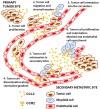Targeting the CCL2-CCR2 signaling axis in cancer metastasis
- PMID: 26885690
- PMCID: PMC5053756
- DOI: 10.18632/oncotarget.7376
Targeting the CCL2-CCR2 signaling axis in cancer metastasis
Abstract
The CCL2-CCR2 signaling axis has generated increasing interest in recent years due to its association with the progression of cancer. Although first described as a chemotactic molecule with physiological roles in regulating inflammation, recent studies have revealed a pro-tumorigenic function for CCL2 in favoring cancer development and subsequent metastasis. CCL2 binds the cognate receptor CCR2, and together this signaling pair has been shown to have multiple pro-tumorigenic roles, from mediating tumor growth and angiogenesis to recruiting and usurping host stromal cells to support tumor progression. The importance of CCL2-CCR2 signaling has been further championed by the establishment of clinical trials targeting this signaling pair in solid and metastatic cancers. Here we review the roles of CCL2-CCR2 signaling in the development and progression of cancer metastasis. We further evaluate the outcome of several clinical trials targeting either CCL2 or CCR2, and discuss the prospects and challenges of manipulating CCL2-CCR2 interaction as a potential approach for combating metastatic disease.
Keywords: cancer metastasis; cancer therapy; chemokines; clinical trials.
Conflict of interest statement
The authors declare no conflicts of interest.
Figures


References
-
- Statistics OfN. London: ONS; 2013. Cancer survival in England: patients diagnosed 2008-2012, followed up to 2013.
-
- Rollins BJ. Chemokines. Blood. 1997;90:909–28. - PubMed
-
- Zlotnik A. Chemokines and cancer. Int J Cancer. 2006;119:2026–9. - PubMed
-
- Balkwill F. Cancer and the chemokine network. Nat Rev Cancer. 2004;4:540–50. - PubMed
Publication types
MeSH terms
Substances
Grants and funding
LinkOut - more resources
Full Text Sources
Other Literature Sources
Molecular Biology Databases

